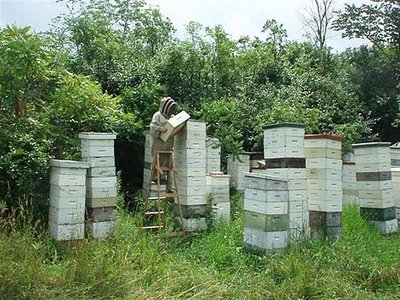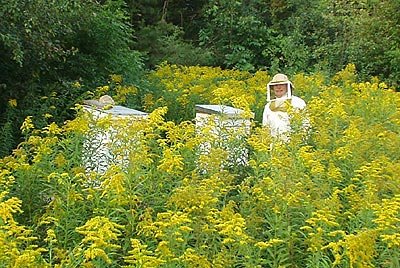Traditions & Changes
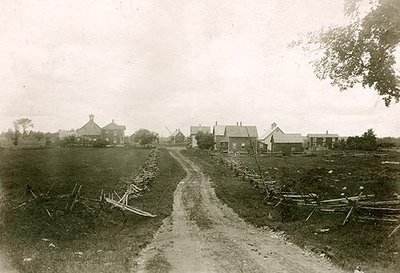
Our first honey house was in the international village of Morses Line, Vermont & Quebec. On the right of the road is the old Richard Brothers Apiary that we moved into. The second building on the right is the Bucket-of-Blood bar, with the Vermont-Quebec border in the middle of the bar. In the Prohibition, the customers would move north to Canadian side for liquor the name of the bar and remnants of glass in the back yard attested to some of action in this building. The buildings on the left are all in Quebec. The forage for the bees was abundant, and they were independent of any boundary or business there.
If you draw a line from the United States north into Canada, the further north you go, the more honey the bees generally make each season. Our first honey house was as far north as one could go in the United States, in Morses Line, Vermont, north of the US Customs office and hugging the Quebec border. The flowers from the dairy farming community on both sides of the international line supported our bees as they gathered nectar, pollen, and propolis. The two Richard Brothers 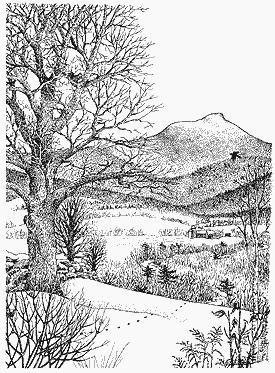 had kept bees here for years, and we continued that tradition, working with a peak of around 180 colonies of bees in Franklin Country, Vermont.
had kept bees here for years, and we continued that tradition, working with a peak of around 180 colonies of bees in Franklin Country, Vermont.
This is a bi-lingual community the language would gracefully move in out of French and English throughout the day. There is an innocence that is so pure here I remember going to a baseball game in Montreal with one of the neighbor children, and he remarked that the buildings were taller than his silos. The farms here are a sacred space, and are passed down from generation to generation in families that carry their traditions forward in time. We began here with a two seater outhouse, a mortgage of $130/month and a huge, sacred poplar tree in the front yard that gave propolis to the bees (seen as a smaller tree in this picture, on the right of the road.)
Our bees are all wrapped for the winter now. They are stronger than they were 12 months ago, with many more bees of the Russian, mite-resistant stock than we have ever seen. For years we have wrapped them, and when the last yard is completed, there is a peace that settles over the honey house. The hard working bees are insulated from the cold winds, snow and rain. With more than 30 bee yard locations, the wrapping takes weeks and is a rhythm of fall moving into winter that invariably ends with time outside in the snow in a polar environment. This year we started to bring four bee hives tight together, and wrap them in a cluster so that they may share their heat and move through the winter as stronger families. These changes convey and air of hope and promise to the bees.
We are continuing to work with our bees with organic policies. It is expected that at least 30% of the colonies may pass on this winter, and from the stronger survivors we will raise more queens, with the genetics of the Russian bees providing mite resistance. We will not use any chemical medicines to artificially allow the weaker colonies to live. Our organic procedures will protect our Apitherapy raw honey and our traditional plant medicines made with this honey. We feel that every action that we move through regarding the bees is transmitted into the integrity, medicinal and food value of our honey and plant medicines.
There is a new snow today covering the honey house and the fields around here. The snow is welcome as it will insulate the nectar plants, bring water and nitrogen to these plants, and remind us to get our cross country skiis and skates out of storage. As we wind down this season and anticipate the holidays, we reflect on the years of the rhythms of traditions of working with the bees. So much is old, and also so much is new as we learn more about how to have a relationship with the bees that are facing so many environmental challenges. .
About 40% of what you eat depends on pollination by insects, much of this by honey bees. With the decline in bees, gardeners and farmers have been noticing less crops honey bees are the “canaries in the coal mine”, and they have helped us be more aware of changes in our environment. We are grateful to be sharing the traditions of beekeeping and plant medicines with all of you and send you our best and the end of the agricultural season and beginning of ![]() new seasons.
new seasons.
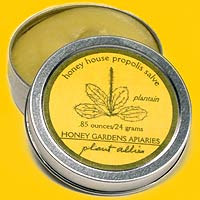 I envision Honey Gardens as a string of partnerships across the land, with our most honorable market, those who work in stores, you who provide the demos at stores in the grassroots of education, the herbalists and scientists who we ask for help, the organic farmers we partner with and adore, our faithful business partners & suppliers ~ thank you. Our Honey House Propolis Salve is solely the creation of Tim, with some of his words below. Todd
I envision Honey Gardens as a string of partnerships across the land, with our most honorable market, those who work in stores, you who provide the demos at stores in the grassroots of education, the herbalists and scientists who we ask for help, the organic farmers we partner with and adore, our faithful business partners & suppliers ~ thank you. Our Honey House Propolis Salve is solely the creation of Tim, with some of his words below. Todd
First of all, thank you to the myriad strands of life’s web for the gifts of medicine bestowed to us along with the responsibility to share and rejuvinate these connections. We are constantly amazed by the work of the bees and the apothecary of medicine they produce. Raw honey has been used for thousands of years as a food and topically as treatment for burns and wounds. Honey is hydroscopic, drawing moisture from the environment, effectively incapacitating infectious bacteria. It has an acidic pH which further dissuades microbial colonization and has been found to contain inhibine which is akin to hydrogen peroxide. Honey also coats exposed, irritated nerve endings inhibiting oxidation, thus relieving pain. The bees make propolis by combining resins (from poplars and conifers), beeswax, and pollen. Propolis (bee-glue) strengthens waterproofs and sterilizes the hive. Propolis is antibiotic, antiseptic, antifungal, antiviral, anti-inflammatory, and analgesic (numbing pain). At Honey Gardens, we were inspired to combine raw honey, propolis, and beeswax with olive oil infusions of comfrey root, calendula flowers, and plantain leaves. Comfrey root knits wounds together, promotes cell repair, and heals burns. Calendula flowers sooth inflamed tissues, burns, and stimulate healing of wounds. Plantain leaves are astringent drawing infections to the surface, promoting healing of injuries. Each herb also helps stop bleeding. The propolis acts as a resinous bandage, protecting the wound. Apply Honey House propolis salve to burns, wounds, bruises, swellings, stings and damaged/dry skin
